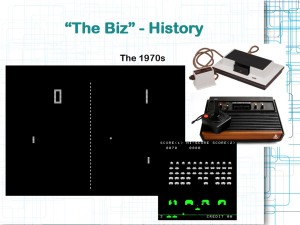Making Money Making Games – Part 1 (History)
Posted by Rampant Coyote on December 9, 2014
I gave a presentation at BYU for their game development club a few weeks ago called “Making Money Making Games – a Historical Perspective.” I didn’t do my best job ever on it, and ran out of time for the “important stuff” at the end, so I kinda breezed through the end. So I thought I’d post it here this week, as I’ll be in Japan and need some prepared posts. I’ve adapted it for the blog, and hope you’ll find it interesting.
How do you make money making video games? I’m not talking about getting rich or anything, a different topic for which I clearly haven’t found an answer yet. I’m not even talking about making a living. I managed to do that successfully for several years as a full-time employee developing games. That’s the ideal, right? Make enough that we don’t have to take on another job to finance our game-making habit.
But I’m talking about the whole concept. Whether it’s an indie like me scraping by enough part-time to be able to afford to keep making games, or how the entire industry builds and sells the games that we want to play, I want to talk about how that’s been addressed in the past, present, and maybe how it will be addressed in the future.
Some people may consider it a gauche topic, but it’s critical to how we make and play games. Even if you don’t intend to ever make a game for any kind of profit, or even make games at all, it’s important. It has to do with how we all, as players, pay for these games to be made. We may find some ways acceptable and some – not so much.
Of course, a big part of my objective here in this series is to illustrate how many things have changed and continue to change (which means – opportunity!), and how many things are tried-and-true principles that are a foundation for everything else. If you are an aspiring or beginning game developer, you need to pay attention to both!
Historical Perspective on the “Industry”
First off, how has the games biz – when there was one – considered games? How did they try and turn this hobby into an industry with actual budgets and stuff?
Ah, the 1960s. The era of the Beatles, the space race, and… video games. Actually, one of the candidates for the very first video game is Tennis for Two, which actually came out in 1958, but I didn’t want to devote an entire decade to one game, so I’ll lump it in here. It’s sparse enough as it is.
In this era, there was no industry – no biz to speak of. Video games were little more than diversions for engineering students, or “gee whiz” displays for visitors. Teams were extremely small – often individual tinkerers who would make changes to the code or spawn off new versions.
Notable games of the era (besides Tennis for Two) include little programs that played Tic-Tac-Toe, Chess, and of course Spacewar!
The platforms of the era pretty much dictated the market (or the lack thereof) – big mainframes or “minicomputers” (which only took up a wall, not an entire room) costing tens or hundreds of thousands of dollars. This wasn’t consumer technology, and so the games were freely distributed to those institutions that had the machines.
But some people were already getting some ideas of turning these things into a commercial venture. It was only a matter of time… and for the price of the hardware to get low enough that consumers might get their hands on it in one way or another.
In the 1970s, we finally had the video game and computer game era take off. You still had the freely-distributed (and often deleted & lost forever) games on the big university and business systems, but you also had Nolan Bushnell – who had seen Spacewar! in action at the University of Utah and wanted to bring it to the masses – in the form of an arcade kiosk.
And so the video game industry had its beginnings. You had the first arcade games by Nolan Bushnell, with expensive dedicated hardware that would finance itself by selling gameplay at a quarter per session. And you had the first game console by Ralph Baer, an expensive bit of consumer electronics that would plug into televisions (light gun sold seperately). And the beginnings of purely digital games (no electronic hardware required) for early consumer computers. Even then, there were a few different business approaches.
Notable games of the era were Computer Space, Pong (and tons of variations), the Colossal Cave Adventure (under various names), Star Trek (AKA Trek), Hunt the Wumpus, Oregon Trail, Zork, Space Invaders, Galaxian, Scott Adam’s early adventures (Adventureland!, Pirate Adventure, and Secret Mission), the original (limited) release of Akalabeth: World of Doom, and MUD (the first massively multiplayer online RPG – well, for very small values of “massively”).
Platforms exploded in this era. You had several consoles – the Odyssey, Odyssey2, the Atari 2600 (AKA VCS), the Apple II, numerous arcade platforms (many with dedicated hardware), the TRS-80, and – squeaking in at the tail end of 1979 – the Atari 400 and Atari 800 computers. And more.
At this point, games were still developed by small teams or individuals. It was a time of entrepreneurs, trying wild ideas that were as “indie” as anything we see today. You had video games as site-based amusements that were paid for a session at a time. You had freeware at universities. You games as an integral part of stand-alone consumer electronics. You had games as a separate but critical component of consumer electronics that you bought individually. You had mail-order game businesses. You had games sold in computer stores in plastic baggies. Games as a mail-order business.
But the explosion had only begun.
To be continued in Part 2…
Filed Under: Biz, Game Development, Retro - Comments: Comments are off for this article

